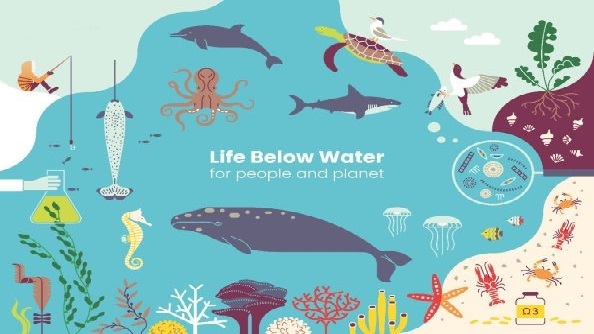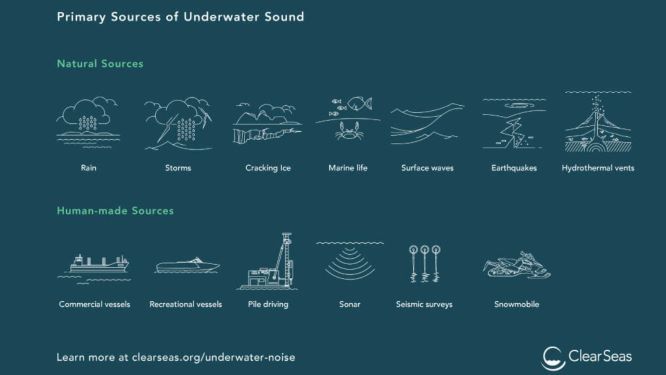InHearing Range. Noise Pollution and its Impact

On March 3, The international community celebrated its first World Wildlife Day 2019, which brought focus on marine species and aligns closely with the Sustainable Development Goal 14 – Life below water, their value in the ecosystem and highlighted a major threat to their survival and health -noise pollution.
In India, there have been many disruptions which over the years have corresponded to unusual behavior amongst animals.
Below the water
More than 80 pilot whales stranded mysteriously on a Tamil Nadu beach in 2016. Though it was unusual for us Indians, incidents like this have become increasingly common across the globe. Similar incidents took over 600 whales in New Zealand (February 2017), 150 in Western Australia (March 2018), and 140 whales again in New Zealand (November 2018).

“Huge noise like military sonar impacts whales and dolphins; it causes mass strandings that often kill over a hundred whales at a time”, Dr Caitlin Kight, a behavioral ecologist from the University of Exeter.
Apart from sonars (which supposedly give off a sound equivalent to a rocket taking off), noises from exploratory missions for oil and gas, large ships and seismic surveys are also unbearable to animals living in the ocean.
In February, a study was published in Proceedings of the Royal Society showing that whales exposed to naval sonar died of decompression sickness. But if you missed this news, then you might have read about how noise pollution in the oceans has been a major factor behind recurring episodes of mass stranding since the 1960s.
Sound is an important medium for many marine organisms to communicate, navigate, mate and find food. Noisy environments aren’t just a distraction, they’re extremely stressful for these creatures, leading to them being injured, confused or disoriented enough to get themselves stranded on beaches with no intentions of doing so.
“No one has comprehensively studied the impact of noise pollution on wild animals in India… No efforts are taken in India to control it”, Dr Sankar Kalyanasundaram, Director of the Salim Ali Centre for Ornithology and Natural History (SACON) in Coimbatore.
We now know, for example, that the foraging, vocal behaviour and physiological stress of cetaceans – whales, dolphins and porpoises – can be impacted by ship noise.
Above the ground
For example, bats and dolphins rely on high frequency sonar to detect highly mobile prey, while great tits, red deer and grasshoppers are among the many species that advertise their dominance and desirability using vocalisations. Elephants can even use sound to determine the threat presented by different human groups.

In the West Bengal city of Raiganj, sudden bursts of loud noise were shown to freak birds out. They flew from their nests leaving their babies unguarded and had lower life expectancies impacting generations.
A different study in West Bengal looked at how noise from mining and stone crushing affected birds, finding that the density and diversity of birds in these noisy areas was far lower.
Dr Kight believes that many songbirds that once lived in cities have fled them or altered the frequency of their voices to still be heard by their kin.
“It is heartbreaking that many songbirds have fled from our cities as they need to find habitat where they can actually hear each other in order to find mates”, Kight says.
Till recently, researchers thought that constant exposure to noise affected basic functions of life in animals — mating, foraging and migration patterns. Recently, research has also shown that it could alter genes and DNA in these animals.
Noise: Not good for anyone
Constant exposure to loud sounds have put one billion people on earth at risk of permanently damaging their hearing, UN health experts have warned. And this is not all — it could also damage your mental capacities.
“Over a billion young people are at risk of hearing loss simply by doing what they really enjoy doing a lot, which is listening regularly to music through their headphones over their devices,” said Technical Officer Shelly Chadha, who works on preventing deafness and hearing loss at the World Health Organisation (WHO), as per a PTI report.
Rapid urbanization is the major cause of noise pollution and it has numerous reasons:
- Outdoor noise caused by machines, transport and public address systems
- Poor urban planning which puts industrial, residential, and commercial areas in close proximity resulting in increased noise in residential areas
- Noise pollution in residential caused by automobiles, construction work, community festivities, recreational activities, loud music, playgrounds, electricity generators
Experts say that the impacts on wildlife can be minimized by reducing noise at key intervals like early morning or breeding seasons. Also, it is necessary to create buffer zones and erect noise barriers for particularly sensitive areas like national parks and sanctuaries.
Our development plans should also be mindful of these impacts. Scientific precautionary measures before urban development action can bear multiple environmental benefits. Avoiding urban sprawl by building compact settlements is helpful for both humans and wildlife.









